Prepare to pay for your transgressions with some seriously damaging power in Hell Girl.
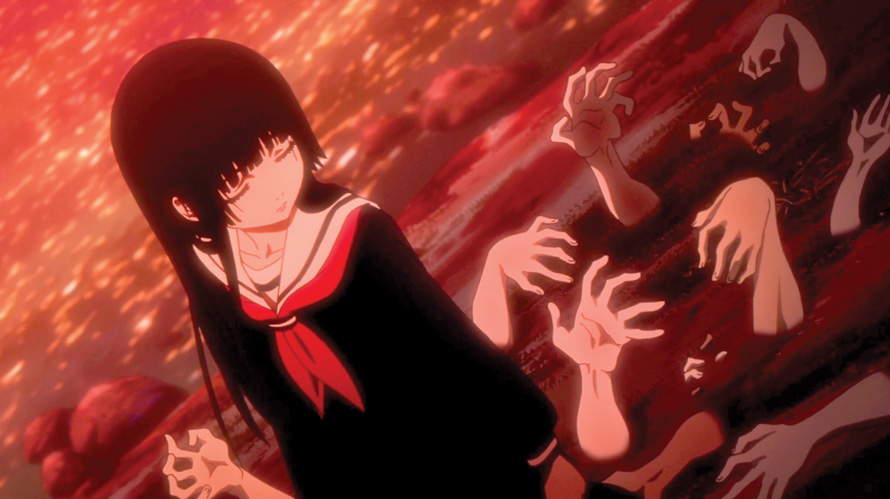
What if sending your mortal enemy to Hell was as simple as typing their name into a website?
Rumors are spreading about one such site, Hell Link, which can only be accessed at the stroke of midnight by tortured souls pushed to the very brink of desperation. The site summons the raven-haired, crimson-eyed Hell Girl (Ai Enma), who can immediately send your tormentor to Hell. There’s just one little catch: by condemning someone to hell, you, too, will wallow in agony for eternity. But … that’s only after you die. So what does it take for someone to put their immortal soul on the line in exchange for a lifetime free of the worst strife they’ve known thus far? Welcome to the world of trigger warnings and bittersweet endings that is Hell Girl.
Born from Hiroshi Watanabe’s original concept and animated by Studio DEEN, Hell Girl (Jigoku Shoujo) first appeared as a 26-episode series that started in 2005 and has since seen three subsequent anime seasons, several manga iterations, and a live-action TV drama. Almost every stand-alone, 30-minute vignette comprising the anime series builds an impressively oppressive atmosphere of psychological/physical abuse through various scenarios that push protagonists off the cliff of sanity. Unkindness knows no bounds here; there is adultery, just about every brand of betrayal imaginable, blackmail, kidnapping, molestation, murder, and so much more—all exploited as drama for the benefit of the audience. It’s not so much torture porn as it is … well, to be truthful, that’s exactly what it is. Thankfully, there’s no rubbernecking pleasure to be had in any of the depictions of said abuses, which range from tastefully implied to gorily explicit, but watching hell-dealt, Dante-esque comeuppances come down upon the repugnant perpetrators would not be nearly as satisfying if the audience did not feel as though they’ve suffered the same times and trials as the protagonists.
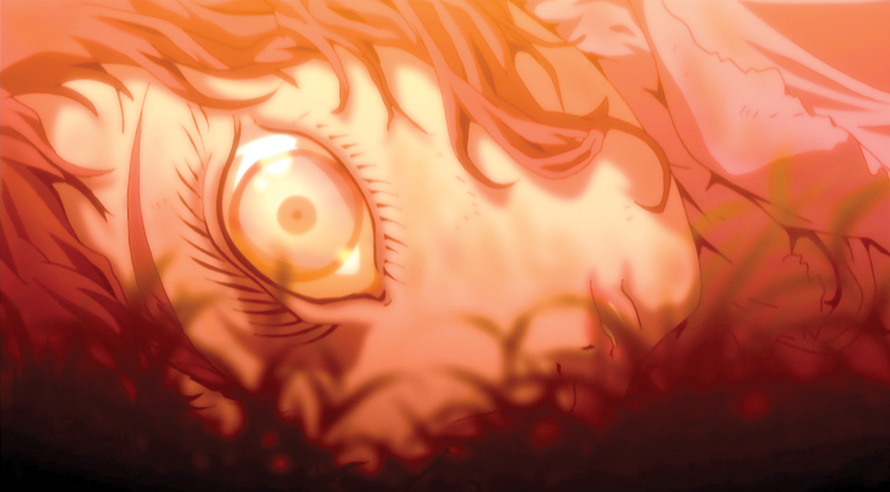
After the camel’s back breaks under one straw too many and the protagonist enters into a contract with Ai by untying a red thread from around a proffered straw doll’s neck, punishment is swift … and entertaining! The condemnation sequences that follow often impose dream logic on the condemned to make believable the absurd and random events of nightmarish scenarios, which can lean grotesque, silly, or outright comical. Each condemnation is tailored to the antagonist’s aggressions, and the themes of the tortures or characters from the vignette are often carried over to the slow and fateful ferry ride by which Ai consigns grievance after grievance to Hell’s shore. These sequences are twofold in purpose: they give the audience a breather from the episode’s oppressive atmosphere and either offer up some hellish justice as heroic contrast or enhance pity for those unjustly condemned.
But because the series is so good at twisting the audience’s emotions, the denouement to each episode won’t let souls rest easy. A brief snippet into how much better off life is for the protagonist is twisted when each and every one, for whatever reason, feels compelled to pull down the neck of their shirt ever so slightly to show the camera the tattoo that indicates that they are destined for Hell when they die. But this twisting of emotions doesn’t just apply to the vignettes, and the vignettes are not all there is
to Hell Girl.
Stand-alone stories are great, but there’s a formula to them. And even though individual episodes play with chronological structure in terms of summoning, backstory, and sentencing, the series would be repetitive or, worse, pointless if that’s all there was to the show.
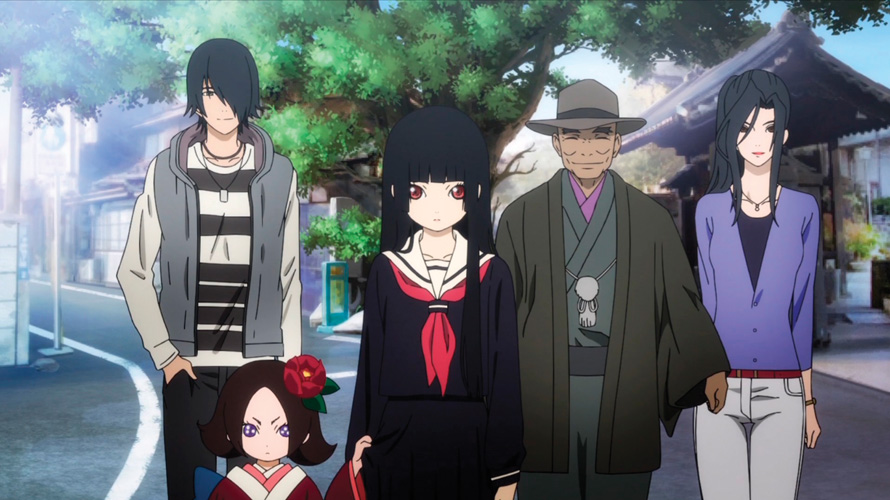
What the vignettes really do is let the viewer sink into the essence of the season before becoming enthralled with the twist that is each season’s through-plot. Seeds subtly planted somewhat early on come into play in later episodes and generally contrast or play upon the theme presented thus far to bring home an often emotionally wrenching seasonal climax. This acts as Hell Girl’s most laudable aspect: twisting its narrative/message inside-out both within and between seasons. As adept as the show is at showing one-off characters descend through various stages of desperation and then plummet into madness, what it does with the characters that appear throughout the majority of the 26-episode seasons is magical (sometimes literally: see sidebar).
Ai Enma’s a death god (shinigami). Her attendants are Wanyuudou (the spirit of a wheel that appears as an elderly man or a gigantic flaming wheel), Hone Onna (literally “bone woman”—the ghost of a betrayed prostitute), and Ichimokuren (the spirit of a blood-drenched sword that appears as a handsome young man or a huge disembodied eye). Condemnation sequences are awash in blood and bone and bound with viscera, yet the real monsters in Hell Girl are the townspeople, the regular folk, humans. The series makes it a point to establish Hell Link as having existed for at least 400 years—adapting to a website from a newspaper column from a stone tablet hung at a temple, and the only constant is the lengths to which fear and hatred will inevitably drive humans.
Ai is bound by fate to perform her duties as a shinigami for hire. Given how little human nature has changed, the toll on Ai’s mental state for carrying out such a morbid duty across the ages is great. Add a chink to her amnesic armor exploited by the progression of events throughout individual stories and the seasons themselves, and suddenly this blank-faced grim reaper who almost never blinks becomes hell on Earth. All that tension from previous stories never really lets up. It just hides in the background of faux resolution (and in the back of your mind for having consumed it) and jumps out as one of the most aptly used scare tactics of the series: unbridled anger.
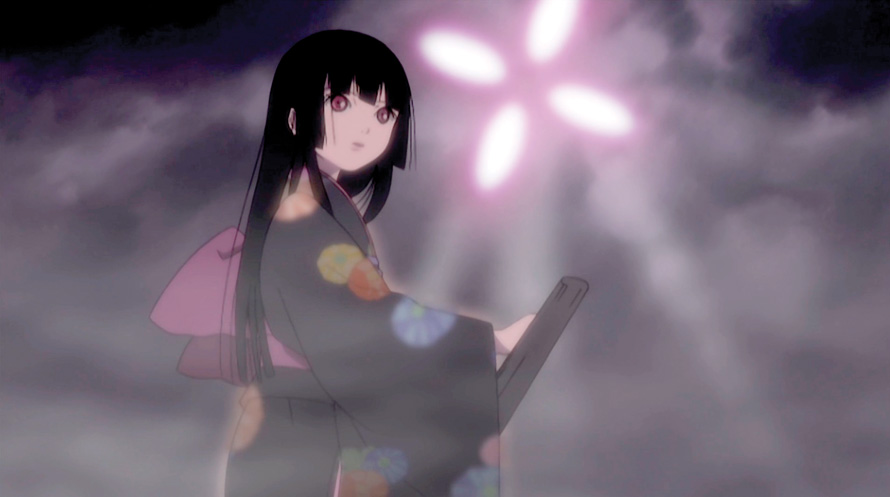
Anxiety and hostility evolve characters and those they interact with through some excellent as well as over-the-top animation and voice acting. The characters experience a ton of subtle emotions and emotional changes, and the way they are brought out ranges from purposefully cheesecake to a little too real for comfort … which is more or less the point; showcasing the ugly side(s) of humanity to prevent its audience from becoming what they see is what this show is all about. While the condemnation sequences are surreal and scary, what really hurts is the reality regarding the weight of objects and force of impacts.
Hell Girl takes place in a real world with real people, and a lot of its believability stems from the series taking place throughout a world inhabited by a ton of distinct people and not keeping actions relegated to, say, a classroom filled with (junior) high school kids. Mariko Oka handled character design for all four seasons, so she definitely had her work cut out for her. Every character in Hell Girl visibly varies in weight, height, and age, and the degrees in which they do so is laudable. The cityscapes, landscapes, and backgrounds are all pretty excellent too and get better as the series progresses. Knowing a little about the language of flowers will definitely help, especially in sensing the tone of the twilight house (Ai’s dusk-bathed home between Hell and the world of the living), but most every setting is deliciously doused in a color palette that makes your eyes drink in the tone.
Even though its themes and tone are pretty dark overall, Hell Girl knows how to balance its act. Whether this is due to the influence of director Takahiro Omori or series creator Watanabe, all viewers can be is thankful for those oases of levity … for the most part. Season 1 takes liberties with certain situations and some condemnation sequences to make light of circumstance and character, while Season 2 (Two Mirrors) and onward, which hosts a little more emotive Ai, actively (and quasi-unfortunately) employs a comic relief pro/antagonist by the name of Kikuri who joins Ai’s team. Comic relief is incredibly important in a series such as this, especially if you’re watching more than a couple of episodes in a row. Unfortunately, the comedic aspects after Season 1 are rather grating; they still provide a break, but you’ll probably wish they didn’t.
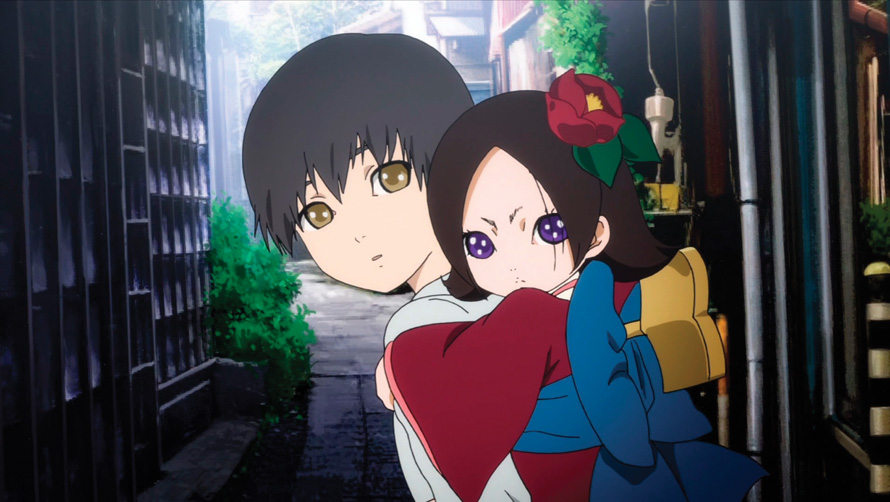
Even though it first appeared in 2005, Hell Girl continually evolves right up until the presently airing season. It’s not a series I’d recommend marathoning, but it’s definitely one that deserves to be watched all the way through. The storytelling is fantastic on a micro and macro scale, the art surprises and delights, and the emotions will knock you out. Highly recommended.
Hell Girl is currently available to stream on Crunchyroll.
This story appears in the Fall 2017 issue of Anime USA Magazine. Click here to get a print copy.


![Yokohama Station SF [Manga Review] Yokohama Station SF [Manga Review]](https://otakuusamagazine.com/wp-content/uploads/2023/11/Yokohama-Station-SF-v2-crop2-480x360.jpg)
![Manner of Death [Review] Manner of Death [Review]](https://otakuusamagazine.com/wp-content/uploads/2023/10/manner-of-death-v2-crop-480x360.jpg)
![Origin [Review] Origin [Review]](https://otakuusamagazine.com/wp-content/uploads/2023/10/origin-10-crop-480x360.jpg)
![Lady Oscar: The Rose of Versailles [Anime Review] Lady Oscar: The Rose of Versailles [Anime Review]](https://otakuusamagazine.com/wp-content/uploads/2021/11/RoV_Vol2_Front_CoverArt_V1-480x360.jpg)
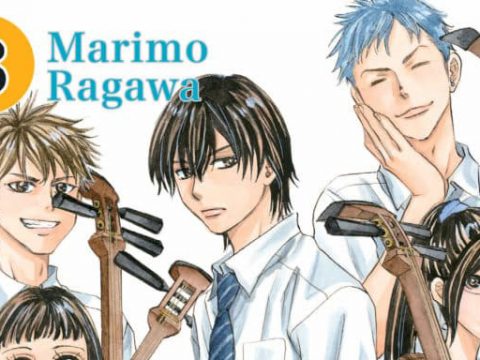
![SSSS.Dynazenon [Anime Review] SSSS.Dynazenon [Anime Review]](https://otakuusamagazine.com/wp-content/uploads/2021/08/16-9-SSSS.Dynazenon_Key_Visual_3.5-480x360.jpg)